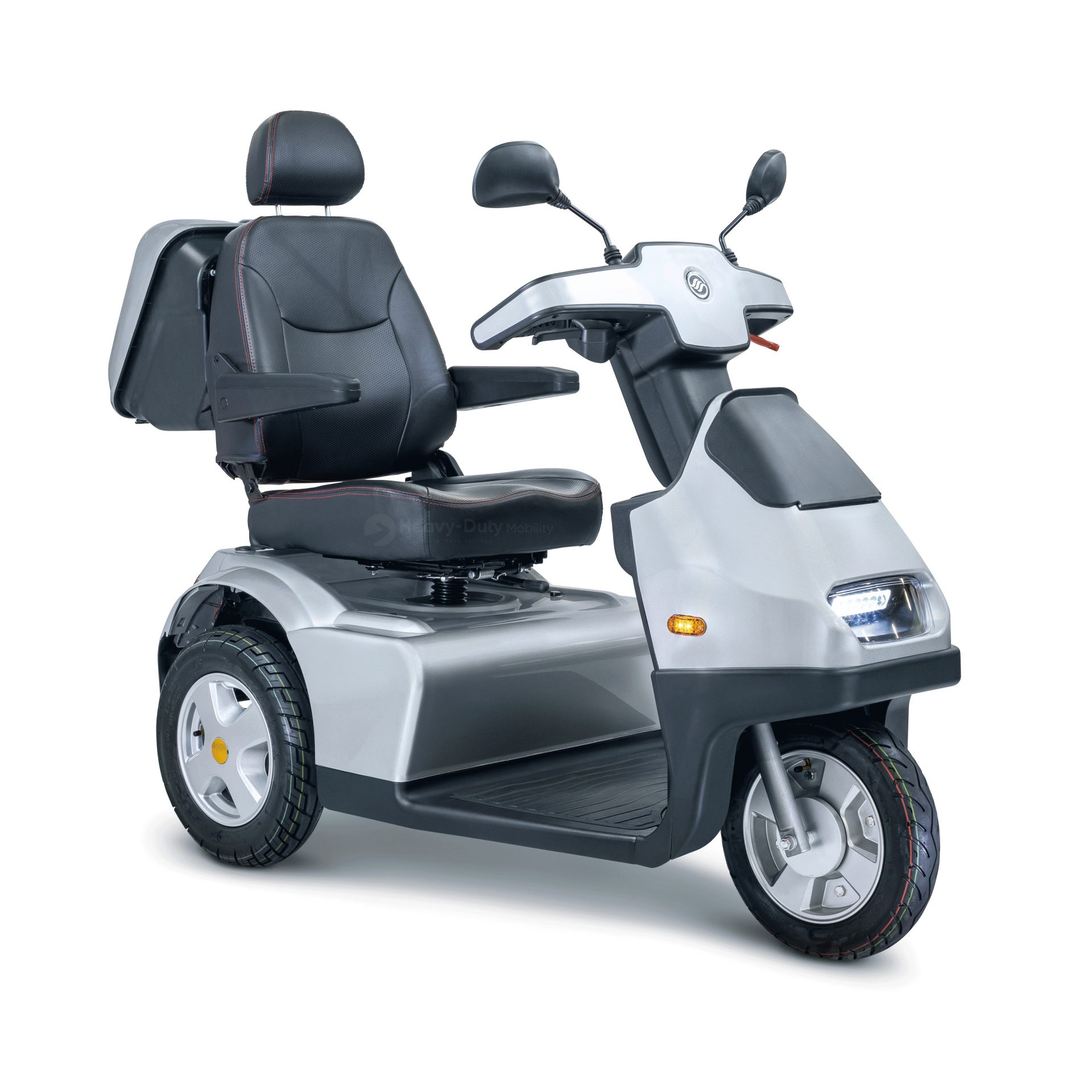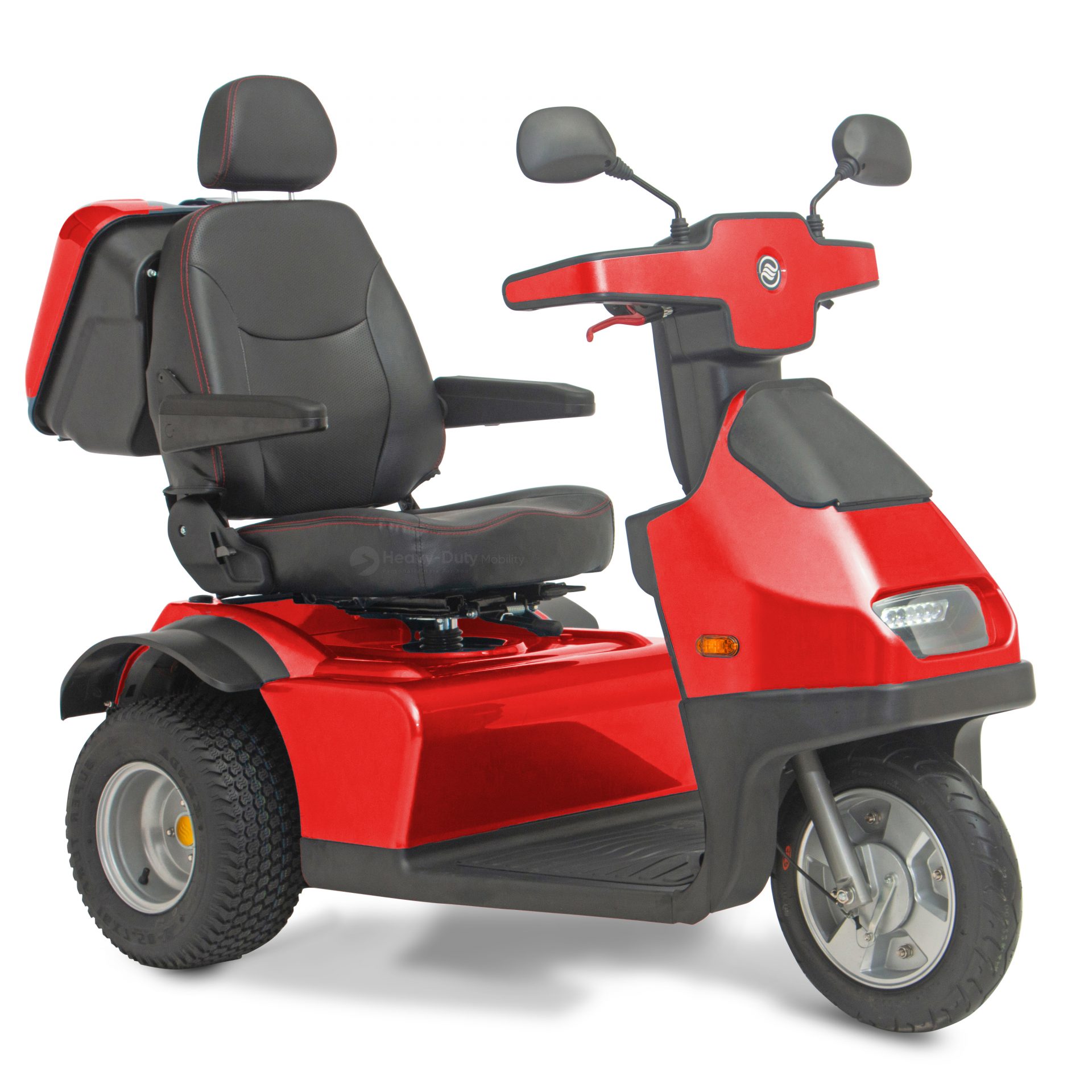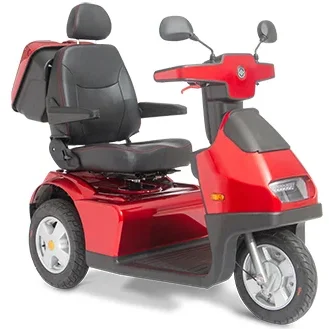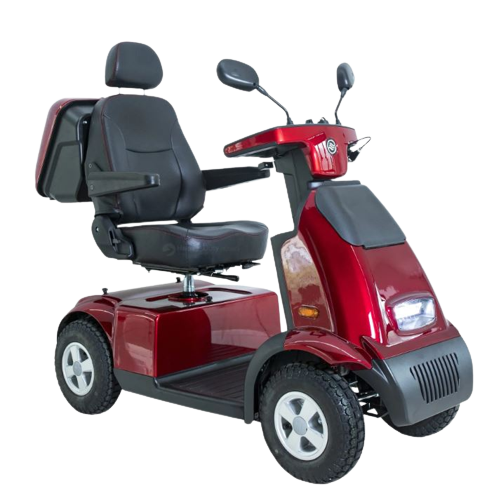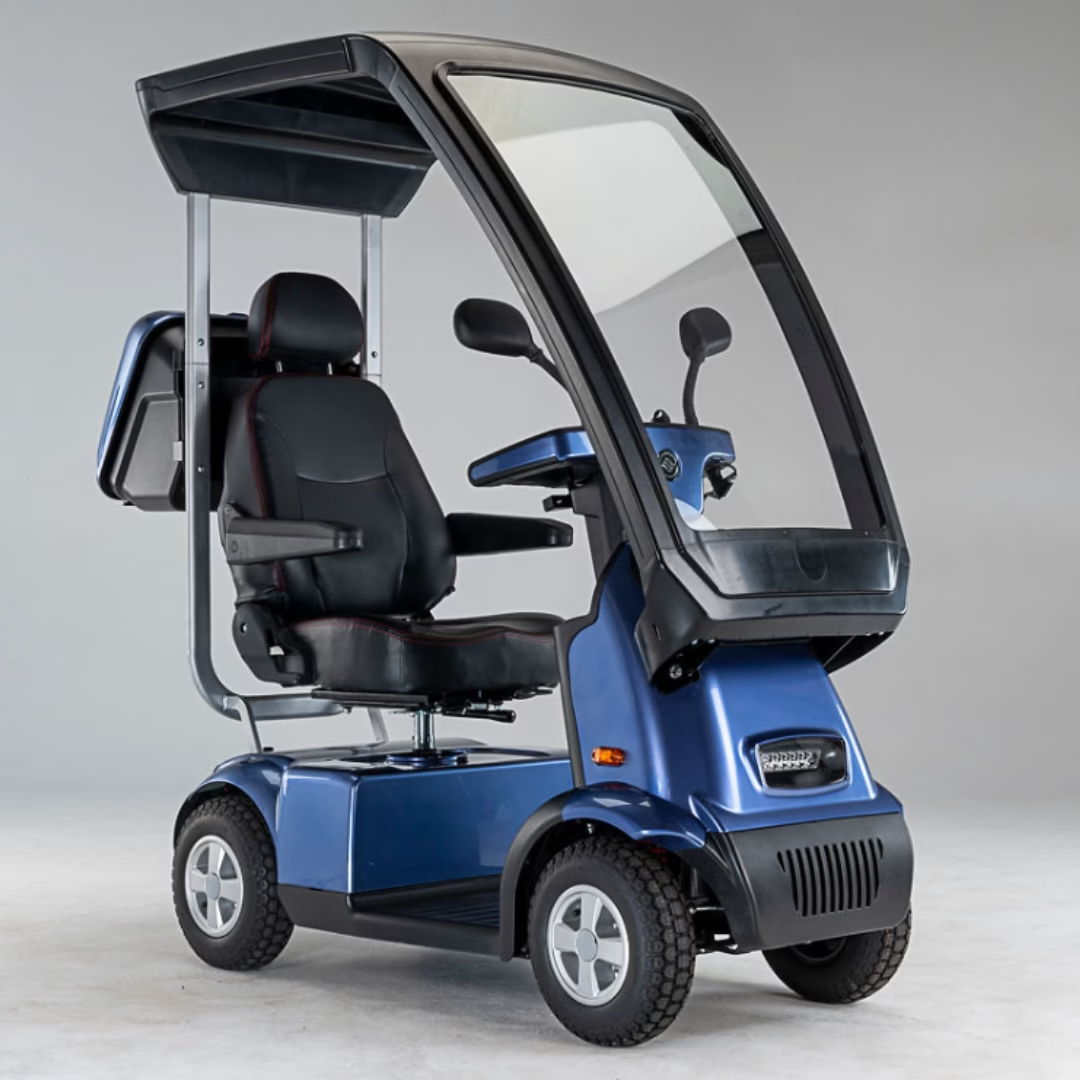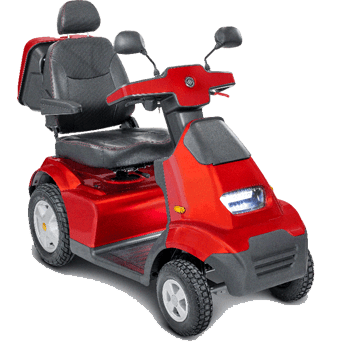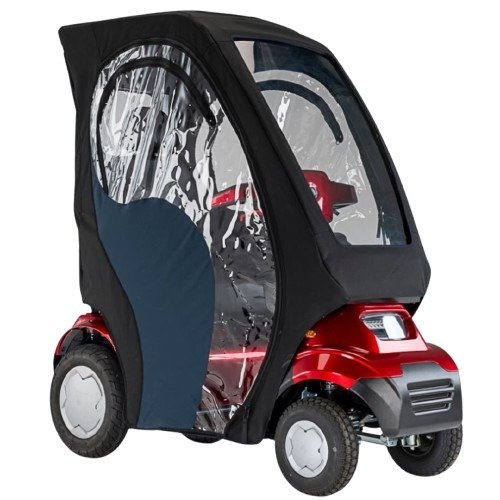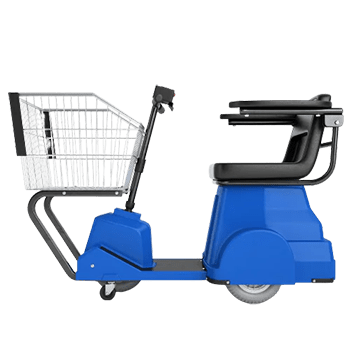Handicap Mobility Scooters
Our Top Pick




$8,069 Original price was: $8,069.$5,309Current price is: $5,309.





$8,519 Original price was: $8,519.$5,719Current price is: $5,719.





$9,049 Original price was: $9,049.$6,529Current price is: $6,529.





$5,829 Original price was: $5,829.$3,969Current price is: $3,969.





$5,945 Original price was: $5,945.$4,641Current price is: $4,641.





$11,999 Original price was: $11,999.$7,683Current price is: $7,683.


What Are Handicap Scooters and How Do They Work?
Handicap scooters are the same thing as mobility scooters
Handicap scooters and mobility scooters are one and the same. Handicap scooters (also known as adult scooters) are small battery powered vehicles meant for elderly or handicapped people to be able to transport themselves. This might be for inside a home, on the sidewalk, through parking lots, inside malls, and other places that people with limited mobility struggle with walking across.
We wish to mention that we understand that the term “handicapped” Or “handicapped scooter” might be offensive to some. We do not intend any offense, we are here to help people to the best of our ability. Since many people are still searching for handicap scooters, wanting to know what they are and how they work we have decided to create this helpful page explaining and answering all questions pertaining to handicap scooters.
Power, steering, tiller, and controls
A handicap scooter always works on electric power from a battery. These are charged from regular wall outlets. The user sits on a seat, places their feet on a deck area, and controls the machine from a “tiller” – a steering shaft which has control on the top of it.
The steering controls sit in front of the user and include handlebars for steering right or left, a throttle to move the machine forward or backward, braking controls, and an information panel. The information panel shows useful information such as how much battery is left. Depending on the model, you might also have front, rear, and turn signal lighting control, and extra emergency handbrake, among other features.
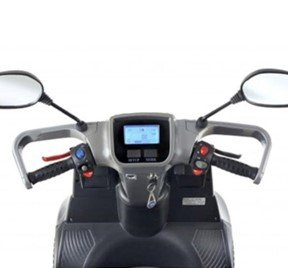

Handicap scooters by definition have a steering pillar in front of the handicapped user and a deck area where the user places their feet. If you see a device with a joystick on the armrest for control and a footplate for your feet, then it is not a handicapped scooter, that would be a power chair or electric wheelchair.
Types of handicap mobility scooters
There are many kinds of handicap scooters for people with all different kinds of situations and looking to be able to traverse different places with their scooters.
Briefly here are the main different kinds of handicap scooters:
- Travel mobility scooters are for people who want to easily be able to travel with their scooter, whether that means taking it in their car trunk, or for airline travel.There are folding handicap scooters, which are often very lightweight, as well as disabling models. There are even handicap scooters that fold or unfold automatically with the push of a button on a remote.
- Heavy-duty handicap scooters are meant for handicapped people who weigh 400 lbs and above. There are bariatric scooter models for patients weighing up to 700 lbs.
- Some people want a fast adventure, and for those, there are handicap mobility scooters that can reach speeds of close to 30 mph
- If you are handicapped and want to travel with a companion on a scooter, especially if one of you has impaired vision or is blind, 2 seater handicapped scooters are a perfect fit. Only one person needs to control the scooter, the other passenger can just ride along.
Who Can Benefit from Using a Handicap Scooter?
Of course, handicapped people who suffer from mobility limiting disability can benefit from using a handicap scooter. A handicap scooter can make an enormous difference in the life of someone struggling with mobility and can decide whether they are able to leave the house, go shopping, or have to stay stuck indoors.
However, it is not only “handicapped” people who can benefit from a handicap scooter. Many non-handicapped people can get a lot of utility and help in their daily lives from a handicap scooter too. We sell scooters to people who definitely do not consider themselves handicapped or disabled, yet love the new opportunities their scooter has afforded them.
Examples include:
- Elderly people who need help getting around their homes.
- Seniors who are able to walk, but not long distances
- People who do not have a driver’s license or had it revoked due to their age and need to travel distances that are impractical to walk.
- People who struggle with vision loss and can’t drive.
- People who simply do not have the strength to walk long distances due to COPD or similar ailments
- People who have a partner who is unable to walk, or limited vision and want to take them around on a 2 seater scooter
- People that have pets that can’t walk long but still want to explore the outdoors
How to Choose the Right Handicap Scooter for Your Needs
In order to choose the right handicap scooter for your needs you must first ask yourself where and how you plan on using it. You might find that you need your handicap scooter for more than one use case or category. Sometimes, you can find a scooter that is suitable for 2 or more categories.
Finding the scooter that fits your needs and lifestyle can feel overwhelming. There are a lot of options to consider when selecting the model that is right for you. When looking at scooters, here are a few things to focus on:
In general, when choosing a handicap scooter think about which use cases you’ll need it for.
Decide what kind of use you’ll need
Do you have to take it in your car or a friend’s car? If so, you might need a folding scooter unless you can install a vehicle lift.
Travel & Folding
If you are looking for a scooter to take on the go, a travel handicap scooter is the best option for you. Lightweight and designed to easily come apart, our travel chairs are ideal for taking on trips, airplanes, and in all-size vehicles. Their compact design allows them to fold up into a suitcase-size frame, making loading them up easier than ever. Setting up and taking apart our travel chairs can be done in minutes.
For compact spaces like tight spaces or small vehicles, a scooter that has the ability to fold up and be put back together within minutes is the best choice.
All terrain & off Road
Selecting the chair that can properly handle the terrain in your surroundings is important. We offer a variety of chairs that are designed for all terrain, meaning they will work effortlessly on tile, wood, concrete, grass, gravel, and more. All terrain scooters are the top choice for customers looking to use their chairs outside of just their homes and stores.
2 seater handicap scooters
2 Seater handicap scooters are great for those who want to travel with a companion such as a spouse, friend, or pet. Some people who have low vision and cannot drive a mobility scooter buy a handicap 2 seater so their companion can take them around. You can get side by side or front to back 2 seat handicap scooters
Enclosed Handicap Scooters
If you live in an area that is windy or rainy, an enclosed handicap scooter can be a good choice. We sell models with just a roof and windshield, models with soft rain sides along with hard canopies, as well as fully enclosed hard door handicap scooters that are basically like micro electric cars.
Bariatric Handicap Scooters
If you’re planning to get a handicap scooter as a heavy person, weighing above 400 lbs – not to worry, we have that covered too! Just make sure your handicap scooters have a weight capacity of 400 lbs or more – we have handicap scooters with weight capacities of up to 600 lbs, such as the Afiscooter S4 or Afiscooter S3 with weight capacity upgrades.
Handicap Scooter Brands
Don’t forget the brand in your decision making! A good brand typically comes with in-home service warranty options. Many good brands actually offer this for free as part of the standard warranty. A good brand will also have an emphasis on quality, longevity of the unit, comfort and high performance.
User weight and height
When making a decision about which handicap scooter to buy, also take into consideration how much you weigh and how tall you are.
How much you weigh determines the weight capacity that your handicap mobility scooter will have to be able to take and how tall you are determines how much comfort you will have.
People will usually prefer heavy duty or altering scooters simply because they have more legroom and also prefer a scooter that has sliders under the seat so they can slide them backward. It will often prefer smaller scooters such as folding scooters which are often much smaller than their counterparts.
People would also like to have a slider under their seat to be able to bring the seat forward toward the tiller. Another advantage for short people is that the Tiller is able to move forward toward the user so that their arms can reach the controls.
For short people whose legs do not reach the deck area of the scooter, it is advisable to put a thick cushion or a low stool so that you can use the scooter just as anyone else with your feet firmly planted on a surface.
Stock levels & shipping times
Another factor to take into account when choosing the right handicap scooter for your needs is how soon you need the scooter. Different brands can have different stock levels and one brand scooter though it might be better for you might not be in stock for a few months, whereas a similar scooter that’s almost as good is available to ship right away.
If you need an emergency handicap scooter “yesterday”, some brands are able to ship it to you within two to three days depending on where you are.
Price
We cannot ignore the elephant in the room – price. We try to have a handicap scooter for every budget, from $650 to several thousand. Of course, different scooters cost different prices.
| Type | Price Range |
| Folding Handicap Scooter | $675 (Shoprider Echo) – $2,850 (Automatic Folding EV Rider Teqno) |
| Travel Handicap Scooter | $949 (Shoprider Dasher 4) – $2,850 (Automatic Folding EV Rider Teqno) |
| All Terrain Handicap Scooter | $4,295 (Cheetah Ninja) – $6,189 (Afiscooter S4 Upgraded Off-Road Wheels) |
| Heavy Duty Handicap Scooter | $1,999 (Shoprider Sprinter XL4) – $8,459 (Afiscooter S4 Dual Seat Fully Enclosed) |
| 2 Seater Handicap Scooter | $2,899 (EWheels EW-10) – $8,459 (Afiscooter S4 Dual Seat Fully Enclosed) |
| Enclosed Handicap Scooter | $4,595 (Cheetah Ninja ADA Canopy) – $8,459 (Afiscooter S4 Dual Seat Fully Enclosed) |
| Bariatric Handicap Scooter | $1,999 (Shoprider Sprinter XL4) – $8,459 (Afiscooter S4 Dual Seat Fully Enclosed) |
Financing on Handicap Mobility Scooters
We understand that some of our scooters are outside the budget of some of our customers and we offer different financing options for those who wish to spread the cost over time.
Depending on your credit score you might be able to get a 0% APR offer for 90 days or split in 4 payments. Those with lower credit scores can still benefit from fair financing APR percentages that start at 9.99%. We are partnered with four different financing partners: Affirm through Amazon, Klarna, Paytomorrow, and PayPal credit for those who have a PayPal account.
Handicap scooters vs electric wheelchairs
When considering how to choose the right handicap scooter for your needs, always remember that it’s possible a handicap scooter is not the best device for your needs and an electric wheelchair might be better.
Electric wheelchairs are generally better for indoors as they are able to turn much sharper and do not have as much ground clearings for obstacles outdoors. If you plan on using your device almost exclusively at home we recommend you think about an electric wheelchair as potentially the better option for your needs.
3 wheel handicap scooters vs. 4 wheel
Another factor to consider when deciding which is the best handicap scooter for your needs is 3 wheel versus 4 wheel handicap scooters. Three wheel handicap scooters are better at turning sharp corners so they’re better for indoors or if you plan to go to small supermarkets with your scooter. Handicap scooters do not turn us sharply, however they are more stable for those who want extra safety and stability.
Transporting your handicap scooter
Before jumping to buy any kind of handicap scooter, part of your needs that need to be considered are your transport needs. Intend to bring this scooter along in a car will you need to use the scooter outside of the radius the scooter can go on from your home on one charge if you need to transport the scooter by car, bus, cruise ship, or airplane you should think about the following points:
Car Inside Trunk
If you’ll be needing to transport your handicap scooter by car, Do you plan on bringing it inside the car or transporting it outside of the car? If you plan to bring it inside the car you will either need a suitable lift or a ramp to bring it in or you will need to double-check that the dimensions fit especially with larger all terrain style models.
Car carriers
If you want to transport this scooter outside of your car which is very common when it’s a mid to large size scooter you have three options. You can either get a manual carrier which has a ramp that folds out from it to allow you to roll the scooter up onto the carrier. Sits on your car hitch and is dependent on the max tongue weight of your car’s hitch.
Scooter platform lifts
The second option is to get an electric Handicap scooter lift. Similar to a manual carrier this sits on your vehicle’s hitch and is bound by the max tongue weight that your car’s hitch can hold.
Electric platform carriers lower down to the ground electrically allow you to roll your scooter on at ground level and then raise it up for the period when you’re driving. You can also flip them up when not in use and some models come with an actual swing-away arm to allow you to have access to the tailgate whilst the scooter is not on the carrier or lift.
We sell electric platform lifts that can accommodate up to 500 lbs meaning that you are covered even for the heaviest mobility scooters., this does not mean that your car will be able to handle that much weight, that depends on the max tongue weight rating of your hitch.
Scooter Trailer
The third option is a ScootaTrailer which is a trailer specifically designed for a mobility scooter or electric wheelchair. Any car or truck can haul this trailer. This is suitable for sedans too.
If you have a truck and want to transport the scooter on your truck bed you will probably need a ramp to get it up to the truck bed especially if it is a larger model. Most larger models do fit on standard truck bed sizes however some dual seat scooters might be too large.
Buses and public transit
If you plan on taking your handicap scooter on a bus, whether a city bus, intercity bus, or local disability transport that has a lift attached it’s important to make sure that the dimensions will work.
The bus companies have a legal obligation to accommodate you but sometimes the weight of your unit or the dimensions of it just won’t work. The same applies to cruise ships and forms of public transit such as subways.
Taking a handicap scooter on an airplane
If you plan on taking your handicap scooter on a bus, whether a city bus, intercity bus, or local disability transport that has a lift attached it’s important to make sure that the dimensions will work.
The bus companies have a legal obligation to accommodate you but sometimes the weight of your unit or the dimensions of it just won’t work. The same applies to cruise ships and forms of public transit such as subways.
Taking a handicap scooter on an airplane
Airplanes will generally accommodate your mobility scooter even if it is large. Is a large scooter, it will usually ask for it to be placed in the hole so you won’t be able to take it all the way to the gate.
Small folding mobility scooters can usually be taken right to the air bridge where they are taken together with baby strollers and returned to you at the same place upon arrival.
Large lithium-ion batteries are not allowed on airplanes so if planning on traveling with your scooter on an airplane make sure the scooter either has SLA – sealed lead acid batteries, or it has lithium batteries that are small enough to be taken on an airplane.
Almost all of our folding scooters have lithium batteries that are small enough to be taken on airplanes.
What Are the Different Types of Handicap Scooters Available?
There are a variety of handicap mobility scooters available to suit different needs and preferences. So, let’s explore the different categories of handicap mobility scooters available:
- Travel Scooters: These lightweight, portable scooters are perfect for running errands or going on short trips. They are easy to disassemble and fit in the trunk of most cars.
- Folding Scooters: As the name suggests, these scooters fold up for easy storage and transport. They are a good option for people who live in apartments or have limited storage space.
- All-Terrain Scooters: These rugged scooters are designed for outdoor use on uneven terrain. They have large wheels and good ground clearance to handle grass, gravel, and dirt paths.
- Heavy-Duty Scooters: These scooters are built for larger riders or those who need extra support. They typically have a higher weight capacity and more powerful motors.
- Enclosed Scooters: These scooters offer protection from the elements, with a roof and windshield. They are a good option for people who live in climates with rain or snow.
- Fast Scooters: If you need to get around quickly, a fast scooter may be a good option. These scooters can reach speeds of up to 20 miles per hour.
- 2 Seater Scooters: These scooters can accommodate two riders, which is a great option for people who want to travel with a companion.
In addition to category, brand is also an important factor to consider when choosing a handicap mobility scooter. Different brands offer different features, warranties, and customer service. Some of the popular brands of handicap mobility scooters include Afiscooter, Enhance Mobility, Shoprider, and VitaFOM.
Another important consideration is the number of wheels. Handicap mobility scooters come in two main configurations: 3-wheel and 4-wheel.
- 3-wheel scooters are generally more maneuverable and easier to turn. They are a good option for people who will be using their scooters indoors or in tight spaces.
- 4-wheel scooters are more stable and provide a smoother ride. They are a good option for people who will be using their scooter outdoors on uneven terrain.
The price of handicap mobility scooters can vary widely depending on the category, brand, features, and options. You can expect to pay anywhere from $675 to $24,775 for a handicap mobility scooter, with heavy-duty models typically costing more, between $2,000 and $7,500.
What Features Should You Look for in a Handicap Scooter?
Choosing a handicap mobility scooter is a significant decision, and it’s important to consider several factors to ensure you get the one that best suits your needs. Here are some key features to keep in mind:
Warranty
A good warranty protects you in case of any unexpected malfunctions or defects. Look for a warranty that covers both parts and labor for a reasonable period. Heavy Duty Mobility offers detailed information that can be found here.
Benefits of Buying Online
While you might be used to visiting a physical store to make a larger purchase, there are many advantages to buying a handicap mobility scooter online. Here at Heavy Duty Mobility, we adhere to MAP (Minimum Advertised Price) standards, ensuring you get the best possible price without extensive price shopping. Additionally, we offer a price match guarantee, so you can be confident you’re getting the most competitive price available.
Beyond competitive pricing, online shopping allows you to browse a wider selection of scooters from the comfort of your home. You can easily compare features, specifications, and user reviews to find the perfect fit for your needs. Plus, online retailers often have special offers and discounts that you might not find in brick-and-mortar stores.
Customer Service
Excellent customer service is essential throughout the entire buying process, from initial inquiries to after-sales support. Look for a company with a reputable customer service department that is easily accessible by phone, email, or live chat. At Heavy Duty Mobility, we pride ourselves on exceptional customer service. We encourage you to check out our reviews on Trustpilot and Google Maps to see what our satisfied customers have to say about their experience.
Matching Your Needs
The most important factor is choosing a handicap mobility scooter that aligns perfectly with your individual needs and lifestyle. Consider your typical usage patterns. If you plan to use your scooter for navigating hills, you’ll need a model with a strong motor and a high incline rating. If portability is a concern, focus on lightweight models that disassemble easily for transport and storage. Think about where you’ll be using your scooter most often – indoors, outdoors, or both. The terrain you’ll be navigating will also influence your choice. By carefully considering these factors, you can ensure you select a handicap mobility scooter that offers optimal comfort, performance, and functionality for your daily life.
How to Maintain Your Handicap Scooter for Longevity?
Just like any other vehicle, your handicap mobility scooter requires regular maintenance to ensure it operates safely and efficiently for years to come. Here are some key tips to extend the lifespan of your scooter:
Use It Within Its Capabilities
Every scooter is designed for specific purposes and terrains. Don’t attempt to use a lightweight folding scooter on rough gravel paths. This can strain the motor and components beyond their intended capacity, leading to premature wear and tear. Refer to your owner’s manual for guidelines on appropriate usage
Keep It Dry
Water and electrical components generally don’t mix well. Avoid leaving your scooter exposed to rain or snow for extended periods. If you’re caught in an unexpected downpour, dry your scooter thoroughly as soon as possible, paying particular attention to the seat, controls, and underneath the chassis.
Battery Care
The type of battery your scooter uses will determine the charging frequency. SLA (sealed lead acid) batteries, commonly found in budget-friendly models, typically require charging 2-3 times per week, even if not in use. This helps maintain battery health and lifespan. On the other hand, Lithium Ion batteries, often used in higher-end models, hold their charge much longer and may only need charging once every 3 months, depending on usage. Always refer to your owner’s manual for specific charging instructions for your scooter’s battery type.
Speeding is Not Recommended
While some mobility scooters can reach higher speeds, it’s important to resist the urge to go too fast. Maintaining a moderate pace reduces stress on the motor and brakes, minimizing wear and tear. Additionally, driving at a slower speed allows for better reaction time and ensures a safer ride.
Yearly Checkup
Similar to taking your car for an oil change, scheduling a yearly checkup for your handicap mobility scooter is vital. A qualified technician can inspect your scooter for any potential problems, perform necessary adjustments, and ensure everything is operating safely and efficiently. Catching minor issues early on can prevent them from developing into more serious and expensive repairs down the road.
Can Handicap Scooters Be Used Indoors and Outdoors?
Absolutely! The suitability of a handicap scooter for indoor and outdoor use depends on the specific type of scooter. Here’s a breakdown of how different types of scooters fare in various environments:
Travel Scooters and Folding Scooters
These lightweight, compact scooters are ideal for indoor use due to their maneuverability in tight spaces. They can also handle smooth, flat outdoor surfaces like sidewalks and paved paths. However, their small wheels and lower ground clearance may not be suitable for uneven terrain or rough outdoor conditions.
Heavy-Duty Scooters
These sturdier scooters are designed for users who require extra support and stability. While they can be used indoors in spacious environments, their larger size might make navigating tight corners challenging. They typically handle outdoor terrain well due to their powerful motors and larger wheels.
All-Terrain Scooters
Built for conquering uneven outdoor surfaces like grass, gravel, and dirt paths, these scooters boast larger wheels, higher ground clearance, and better suspension. Their size and turning radius may make them less suitable for tight indoor spaces.
Fast Scooters
If you prioritize speed, these scooters can reach higher speeds than most other types. They are primarily designed for outdoor use on smooth, flat surfaces. Their larger size and focus on speed may not be ideal for indoor maneuvering.
2-Seater Scooters
If you prioritize speed, these scooters can reach higher speeds than most other types. They are primarily designed for outdoor use on smooth, flat surfaces. Their larger size and focus on speed may not be ideal for indoor maneuvering.
Enclosed Scooters
These weatherproof scooters offer protection from rain, wind, and sun, making them ideal for outdoor use year-round. Their larger size and turning radius may make them difficult to use indoors, particularly in confined spaces.
When choosing a handicap scooter, consider your primary usage environment – indoors, outdoors, or both. Think about the terrain you’ll be navigating and prioritize features that best suit your needs. If you plan on using your scooter in both indoor and outdoor environments, a travel scooter or a folding scooter might be a versatile option, but be sure to consider the limitations of outdoor use. Always refer to the owner’s manual for specific guidelines on appropriate usage for your scooter type.
What Are the Legal Requirements for Using a Handicap Scooter in Public Spaces?
Understanding the legal requirements for using a handicap mobility scooter in public spaces is crucial for ensuring a safe and enjoyable experience for yourself and others. While specific regulations may vary slightly by state or municipality, here’s a general overview of the common legal considerations:
Eligibility
In most jurisdictions, handicap mobility scooters are classified as mobility aids, intended for individuals with limited mobility. This means you’ll typically need a documented disability or mobility impairment to legally operate a scooter in public spaces. Some locations may require a doctor’s note or a permit to verify your eligibility.
Safety Regulations
Speed Limits
Generally, handicap mobility scooters have a designated speed limit, often ranging from 3 mph to 10 mph, depending on the location. It’s essential to adhere to these speed limits for safety reasons and to avoid citations from law enforcement.
Traffic Laws
While not classified as motor vehicles, handicap mobility scooters are often expected to follow basic traffic laws. This includes obeying traffic signals, stopping at stop signs, and yielding the right of way to pedestrians. Always prioritize safety and courtesy when navigating public spaces with your scooter.
Lighting and Reflectors
If you plan on using your scooter in the evenings or during low-light conditions, ensure it has proper lighting and reflectors. Headlights, taillights, and side reflectors are often required for nighttime operations to enhance visibility and safety.
Accessibility and Usage
Pedestrian Right of Way
Always prioritize pedestrians when using your scooter in public walkways. Maintain a safe distance and reduce your speed when approaching or passing pedestrians.
Parking
Utilize designated handicap parking spaces whenever available. If no handicap spaces are available, park your scooter in a safe location that doesn’t obstruct pedestrian traffic. Avoid parking in areas that block doorways or ramps.
General Courtesy
Be mindful of your surroundings and maintain a safe distance from obstacles and other vehicles. Use your horn or bell to signal your presence if necessary. Always operate your scooter in a predictable manner and avoid weaving through crowds.
Additional Considerations
Registration and Insurance
While not always mandatory, some states or localities may require handicap mobility scooters to be registered, particularly if they exceed a specific speed limit. Registration fees can vary by location. Scooter insurance is not typically required by law, but it can offer valuable protection against accidents or theft.
User Proficiency
It’s highly recommended to familiarize yourself with your scooter’s operation and practice in a safe, controlled environment before venturing into public spaces. Ensure you’re comfortable with maneuvering, braking, and turning before navigating crowded areas.
For the latest and most accurate information on legal requirements specific to your area, it’s always recommended to consult your local Department of Motor Vehicles (DMV) or relevant government agency. They can provide details on any registration or permitting requirements, as well as any local ordinances governing the use of handicap mobility scooters in public spaces.
By following these general guidelines and staying informed about local regulations, you can ensure safe and legal usage of your handicap mobility scooter, promoting a more enjoyable and accessible experience for yourself and others.
How to Customize Your Handicap Scooter for Comfort and Efficiency?
While not all handicap mobility scooter models allow for extensive modifications, there are still ways to personalize your ride for increased comfort and efficiency. Here’s a breakdown of customization options to consider:
Universal Accessories:
The beauty of handicap mobility scooters is the wide range of universal accessories available to enhance your experience. These can be easily added or removed to suit your individual needs and preferences. Here are some popular examples:
- Cup Holder: A cup holder keeps your beverages secure and prevents spills while navigating.
- Phone Holder: A phone holder allows you to keep your phone within easy reach for calls, navigation, or entertainment.
- Basket or Cargo Carrier: A basket or cargo carrier provides additional storage space for carrying groceries, personal items, or shopping bags.
- Travel Bag: A travel bag attaches to the back of your scooter for additional storage while traveling or running errands.
- Armrests and Headrests: Many scooters offer the option to add armrests and headrests for improved comfort and support during extended rides.
- Rearview Mirror: A rearview mirror enhances safety by allowing you to see what’s behind you without having to turn your head.
- Non-Slip Mat: A non-slip mat adds a layer of traction to the footrest, improving safety and preventing slipping.
Model-Specific Customizations
Certain handicap mobility scooter models offer more extensive customization options to optimize comfort and efficiency for the user. Here are some examples:
Afiscooter
Afiscooter scooters are known for their modular design, allowing for customization of features like battery range, seat width, and even the addition of a canopy or side panels for weather protection.
Seat Width and Comfort
Many models offer adjustable or replaceable seats to accommodate different user sizes and comfort preferences.
Battery Range
Some scooters allow upgrading the battery for a longer range, ideal for extended journeys.
Color Choices
Most models come in a variety of color options, allowing you to personalize the look and feel of your scooter.
Choosing the Right Model for Customization
If your desired comfort or efficiency upgrades are unavailable on your current model, consider exploring models from brands such as AFIKIM, Enhance Mobility, and ShopRider that offer greater customization options.
What Warranty and Support Options are Available for Handicap Scooters?
When considering a handicap mobility scooter, a comprehensive warranty and reliable support options are important factors to weigh alongside features and price. A strong warranty protects you financially in case of unexpected malfunctions, while robust support ensures you have access to help when you need it.
Understanding your Warranty:
The specific warranty coverage for handicap mobility scooters varies depending on the manufacturer and model. However, warranties generally cover repairs for a set period due to defects in materials or workmanship. For detailed information on the warranty policy offered by Heavy Duty Mobility, you can find it here.
Types of Warranty Service
The type of warranty service offered can also vary. Here’s a breakdown of some common options you might encounter:
- In-Home Service (Free): This is an ideal scenario where a qualified technician visits your residence to diagnose and repair the scooter, minimizing any inconvenience for you. It’s important to note: The availability and coverage of in-home service may differ depending on the specific warranty plan and manufacturer.
- Parts-Only Warranty: This type of warranty covers the cost of replacement parts if your scooter malfunctions. However, you might be responsible for any labor costs associated with the repair.
- Optional In-Home Service (for a fee): Some warranty plans may offer in-home service as an upgrade for an additional cost.
- Limited Coverage Outside the US 48 Contiguous States: Be sure to check the warranty terms carefully if you live outside the continental United States. Warranty coverage and service options may be limited in these areas.
Key Warranty Considerations
Here are some key points to keep in mind when reviewing the warranty on a handicap mobility scooter:
- Warranty Period: This refers to the duration for which the warranty covers repairs.
- Covered Components: This details the specific parts or components covered under the warranty.
- Service Options: This clarifies whether in-home service is included and if it’s free or an optional upgrade.
- Exclusions: It’s important to understand any situations or circumstances that may void the warranty.
By thoroughly reading and understanding the terms and conditions of your handicap mobility scooter’s warranty, you’ll be well-informed about what’s covered, the duration of coverage, and the available service options.
Support Options
In addition to a warranty, reliable support options are essential for a positive ownership experience. Look for a company that offers multiple avenues for you to get help, such as:
- Toll-Free Phone Support: A dedicated phone line where you can speak with a customer service representative about questions or concerns.
- Email Support: The ability to submit questions or request assistance via email.
- Online Support Center: An online resource with FAQs, troubleshooting guides, and downloadable manuals.
By choosing a handicap mobility scooter with a comprehensive warranty and robust support options from a reputable dealer, you can ensure peace of mind and minimize disruptions if you encounter any issues with your scooter down the road.
FAQ’s
What safety features are essential in a handicap scooter?
Safety features that are essential in a handicap scooter are good braking systems, a reliable motor, and an accurate dashboard.
Here is a comprehensive list of important safety features that are essential in a handicap scooter.
- To ensure safe operation, it’s obvious that you’ll have good brakes. Look out for handicap scooters that include electromagnetic brakes. These brakes kick in as soon as you let go of the throttle, bringing your scooter to a safe stop. A backup handbrake is also a critical safety feature. You don’t want to be caught on a steep hill with your scooter rolling out of control!
- Your scooter should have a freewheel mode in case you get stuck without power and need to roll your handicap scooter to safety
- A horn is useful for your own safety – to warn people in danger of colliding with your scooter. A horn can also be useful for the safety of others on the road and sidewalks, whether pedestrians or vehicles.
- For your safety especially at night or in poor visibility conditions, a lighting package can greatly enhance the safety of your handicap scooter. This means a front headlight, rear lights, and turn signals. Particularly if you are going to be using roads, other vehicles that are larger than your scooter pose a safety hazard if they cannot see you or you cannot indicate your intentions clearly.
For handicap scooters that come without sufficient lights, we have optional red and white LED battery powered lights that can be added anywhere on your scooter.
- You’ll want a reliable motor that won’t let you down when going uphill and won’t disengage dangerously into freewheel mode
- Safety starts with the chassis and main build of the scooter – a safe handicap scooter is well built in a way that won’t fall apart on you
- Crucial to safety, especially on sidewalks, is the ability to slow down your speed. A safe handicap scooter has a half speed button or speed dial that allows Youtube greatly reduce your top speed in pedestrian areas
- In order to safely navigate roads and sidewalks on your scooter, you need to accurately know how fast you are going. An accurate speedometer is a must!
- If you don’t want to get stranded in an unsafe place, such as in the cold, it’s important to know how much charge you have left in your battery and calculate your trip accordingly. An accurate battery level gauge on your handicap dashboard is very important for your safety and comfort.
- A safe handicap scooter will have beep error codes to help you understand if anything is wrong with the scooter. Beep codes can help you understand what the issue is with your scooter. Safe scooters will refuse to start up if the error is critical and may impact your safety.
- Manufacturers of safe scooters will include a comprehensive manual to let you know how to use your handicap scooters within the bounds of safety. Some activities, such as exceeding the incline rating or weight capacity of the scooter can be dangerous, so you as the user need this information in a detailed and well-presented form!
- Many seniors like a fast mobility scooter, something that can make up for the lost speed a car or truck once offered. However, beware: a lot of the fast scooter models are made in China and are not as good quality as other slower handicap scooters. Many elderly and disabled people have slower reaction times. Responsible top brands of handicap mobility scooter intentionally cap the top speed of their handicap scooters at around 10 mph. This ensures a safer ride for the passenger in case the scooter has to come to a sudden stop.
- nti tip wheels are a great safety addition on many handicap scooters. Some scooters come standard with anti-tip wheels and some come with the option to add them inside preinstalled metal tubing. All terrain or large, heavy duty handicap scooters will often feature these at the rear of the scooter, since the chance of these large scooters tipping sideways is very low. Smaller, folding handicap scooters may have anti tip wheels on the side since smaller scooters are at higher risk of tipping sideways.
- On models that go faster than 5 mph, some top brands offer seat belts. A seat belt can be a great safety feature in the event of a sudden stop when going at high speeds. For dual seat side by side handicap scooters, we offer a seat belt for each passenger on many models.
How do anti-tip wheels work on handicap scooters?
Anti-tip wheels on handicap scooters work by adding small metal tubes with wheels at the end to catch the scooter in case it tips. This is usually at the back for large or all terrain handicap scooters, but you might also see them at the side of small folding scooters that are more at risk of tipping to the side than their larger counterparts.
If the scooter tips too far back after hitting an obstacle or when on a steep hill, the extra wheels will catch the scooter and prevent any further tipping.
Many scooters will come with tubing where metal anti slide assemblies can be fitted into as an optional upgrade for safety conscious customers.
What are the benefits of electric handicap scooters over manual ones?
Manual scooters for handicapped people don’t really exist. Manual wheelchairs are very common. The advantage of an electric handicap scooter over a manual wheelchair is that you don’t have to use your own strength to propel yourself. The electric motor does the work for you
Manual devices require arm strength in order to move forward. Not everyone has that kind of arm strength, especially for long distances and going uphill. In addition, handicap scooters often come with plush captain seats which you do not find on manual wheelchairs.
Another advantage to electric handicap scooters over manual scooters is the ability to haul cargo such as groceries or a pet without needing to worry that you won’t have the strength.
Can I switch my manual handicap scooter to an electric one?
It is not possible to change a Manual handicap scooter to electric.
It is possible to switch a manual handicap wheelchair to an electric one. You can do this by means of an especially designed pack that hooks onto your manual wheelchair and provides power by means of an extra wheel.
How long does a handicap scooter battery last?
Handicap scooter batteries last between two to five years depending on the technology used. Most handicap scooters use SLA sealed lead acid or gel cell batteries. Last an average of two years with regular use. Some more sophisticated handicap scooters especially folding scooters, use lithium-ion batteries which can last between three to five years.
The longevity of a handicap scooter battery depends on maintenance such as recharging at regular intervals depending on the battery technology as well as charging habits and how often you use the scooter.
Replacement batteries for handicap scooters are between $200 and $400 for lead acid batteries, depending on the size of the scooter.
For lithium batteries, it’s usually more expensive starting at around $600 for replacing a travel handicap scooter’s lithium battery.
What tips can extend the battery life of my electric handicap scooter?
Here are some tips to extend the battery life of your electric handicap scooter.
- When your scooter is new, break into your battery slowly! This means recharging more often instead of allowing the battery to go too far down.
As you go along, you can allow the battery to go down to 90%, 80% then 70%, and 60% percent. Eventually, after a few weeks, you can go down to around 30% battery capacity. - It’s recommended you don’t run the batteries lower than 30% of their capacity for optimal health of the batteries.
- In order to ensure the health of SLA or gel cell batteries which are used in handicap scooters, it is advised to recharge them at least three times a week even if not in use.
- If your handicap scooter has a lithium battery, please ensure to charge it at least once in three months even when not in use
- Though they can work in more extreme temperatures, it’s better to keep SLA batteries between 32 and 105 degrees Fahrenheit. Lithium batteries, which are more sensitive, should be kept between 59 and 95 degrees Fahrenheit.
Leaving your handicap scooter in the hot sun or in an unheated garage in the deep winter can negatively affect your handicap scooter’s battery.
But all the scooters we sell come with batteries that don’t require any further maintenance such as water top up.
Can handicap scooters be used on all types of terrain?
Not all handicap scooters are designed to be used on all types of terrain. We have a dedicated collection page of handicap scooters that are designed to be used on all types of terrain. Popular models include the Vita Monster, Afiscooter C3, Afiscooter S4, Afiscooter S3, and Merits Silverado Extreme.
These scooters and all the others in our altaray handicap scooter page are designed to be able to take you over grass gravel, bumps, and small curbs. These are not all terrain in the sense that an all terrain gas vehicle might be. We define these scooters as all terrain based on a ground clearance of four inches and more. They have enough space underneath them to traverse bumpy areas such as gravel or unpaved roads.
If you need a handicap scooter that is truly all terrain and can go anywhere whether it’s forests trails the beach or other extreme terrains, we do have scooters that can cope with those kinds of terrain spirits please see our EZ Raiders page where the LW, HD2 and HD4 models will take you anywhere you dream, of despite your handicap!
There is also the TerrainHopper Overlander model which can cope with pretty much any kind of terrain, such as forests and mountain terrain.
Are handicap scooters allowed in public buildings and transportation?
Yes, handicap scooters are allowed in public buildings and on public transportation. It’s actually a law that these places have to accommodate the devices handicapped people use for their mobility.
At the same time users of handicapped mobility scooters must ensure they do not pose a danger or threat to the public by dangerous driving such as driving too fast or recklessly in pedestrian and enclosed areas.
For those using handicap scooters, the Americans with Disabilities Act (ADA) ensures accessible public buildings and transportation across the United States. Public places are designed to accommodate everyone, offering features like ramps, wide doorways, and accessible restrooms. Similarly, public transportation systems, including buses, trains, and subways, are equipped with ramps or lifts, priority seating, and space for mobility scooters to make your travels smooth and hassle-free.
Additionally, the Air Carrier Access Act ensures air travel is accommodating for mobility scooter users, providing assistance and eliminating extra charges for scooters. While the ADA sets a strong foundation for accessibility, it’s wise to contact specific facilities or transportation services ahead of time to ensure your needs will be met.
In any case, these laws are there to support your independence and mobility. Should you encounter any barriers, there are resources and advocacy groups ready to help.
Does insurance cover the cost of a handicap scooter?
Yes, insurance does generally cover the cost of a handicap scooter under certain conditions.
Medicare website states that in order for mobility scooters to be covered whether partially or fully the user must require the use of a handicap scooter indoors common not just outdoors.
This limits the amount of people who are eligible for mobility scooters by insurance and also limits the number of models that are going to be covered by insurance as many models are clearly designed for outdoors.
This is especially the case with heavy duty bariatric ultra rain and outdoor mobility scooters which are rarely covered by insurance.
We have generally found that private insurances such as Blue Cross Blue Shield, Cigna and others follow Medicare’s stance when it comes to eligibility for handicapped scooters paid for by insurance.
Also, note that if you’re looking to get a handicap scooter covered by insurance the paperwork besides the doctor’s prescription can be very lengthy and arduous and it might take you several months before you actually see a scooter.
At present we are not able to build insurance, if your insurance tells you they are happy to reimburse you for the cost of a scooter, we will be more than happy to send an itemized invoice to help with this.
What type of insurance is needed for a handicap scooter
As far as we at Heavy Duty Mobility are aware, most insurances will cover handicap scooters only if they are needed for getting around indoors and you have a doctor’s script stating this.
This includes Medicare, who clearly state this in the terms on their website for getting a free or partially paid for handicapped scooter on Medicare.
Please note that:
- We are unable to bill insurance. We can help with paperwork, such as providing an itemized invoice, if they are willing to reimburse you.
- Some companies do bill insurance on your behalf, but have limited models to choose from. This is especially the case when looking for an all terrain, heavy duty or 2 seater handicap scooter.
- The process of getting a scooter paid for by insurance even partially is painstakingly slow, involves a lot of paperwork, and comes without any guarantee that you will see a scooter at the end of all of it. Chances are it could take several months before you see a scooter paid for by insurance.
What is the maximum weight capacity of handicap scooters?
The maximum weight capacity of handicapped scooters ranges from 200 pounds for very lightweight folding scooters all the way up to 770 lbs for 2 seater scooters.
Single seat scooters will usually have around 300 pounds of weight capacity. Folding scooters are more limited due to the materials they are made out of to make them lightweight so the cap on those is usually 250 to 300 pounds.
An exception here are Triaxe Cruze and Triaxe Sport folding handicap scooters which both have a weight capacity of 350 pounds.
Heavy duty handicap scooters start with weight capacities of 400 pounds and go up to 600 lbs on models such as the Afiscooter S3 and S4 (when you purchase the high capacity 600 lb upgrade).
Since two seater scooters have to carry two people, they obviously have higher weight capacities. The highest that we have seen are the Pushpak dual seater handicap trikes with for example the Pushpak 3000 boasting a 770 lb max capacity.
How does weight capacity affect the performance of a handicap scooter?
Weight capacity affects the performance of a handicap scooter in terms of top speed, ability to withstand rugged terrain, and of course ability to take extra weight.
It is obvious that part of the performance of a scooter is how much weight it can carry both user weight and cargo such as shopping or pets. But the weight capacity of a handicap scooter affects its performance in different ways too.
A higher weight capacity means a stronger frame, stronger model, and better build. That is How it is able to accommodate the extra weight. Even if you don’t weigh as much as a higher capacity! First of all, it means you’ll be able to carry more groceries, pets, grandchildren, or whatever you want your handicap scooter to carry.
The higher the weight capacity of your handicap scooter the more performance you’ll get in other areas too. You’ll benefit from faster acceleration, faster deceleration in case of an emergency stop, and a more powerful motor (designed for heavier people). You’ll also get larger batteries with more range per charge.
How fast can a handicap scooter go?
At a top speed of 28 mph, the fastest handicap scooter is the Q Express by Green Transporter. However, the Q Express is strictly speaking not a mobility scooter in the traditional sense. Some municipalities and States might consider it a micro car as it is used by non handicapped people too.
Most traditional mobility scooters will go around five mph and will have speed restriction dials or buttons to help you navigate more slowly in crowded or pedestrian areas.
Other examples of fast mobility scooters include the EWheels range, which is usually at around 15 mph, and the Pushpak scooters, which have an average top speed of 20 mph. Although these EWheels and Pushpak handicap scooters are more similar to mobility scooters than an enclosed vehicle like the Q Express, once again they might not be considered to be handicapped scooters by some municipalities.
This is because they are not as “medical” as the other handicap scooters. True handicap scooters will generally not go faster than 10 mph. Examples of these include the Merits Silverado Extreme and Afiscooter S3, S4, C3, and C4.
The Afiscooter S3 and S4 Have an optional upgrade that brings the top speed up to 11.3 mph.
Most traditional mobility scooters, even all-terrain handicap scooters, are built with safety in mind, which is why they top out at approximately 10 mph.
Are there speed regulations for using a handicap scooter in public areas?
There generally are no speed regulations for using a handicap scooter in public areas. Generally, mobility scooters have a max speed of 5-10 mph, though some go up to 15-20 MPH. Some laws only allow up to 15 mph.
Speed regulations for handicap scooters vary across the country, with local laws sometimes setting limits. For instance, Connecticut allows them if they don’t exceed 20 mph and keeps them off sidewalks, while states like Kentucky and Missouri have their own rules regarding usage on roads, bike lanes, and sidewalks.
The ADA doesn’t set specific speed limits but local neighborhoods might. If you are thinking of buying a very fast mobility scooter (above 10 mph), we advise you to check local regulations for compliance.



 Secure Payments
Secure Payments




